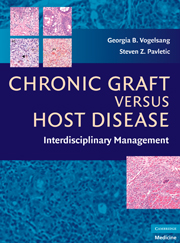Book contents
- Frontmatter
- Contents
- List of Contributors
- Preface
- PART I GENERAL PRINCIPLES
- 1 Historical Aspects of Chronic Graft versus Host Disease
- 2 The Pathophysiology of Acute Graft versus Host Disease
- 3 Pathophysiology of Chronic Graft versus Host Disease
- 4 Animal Models of Chronic Graft versus Host Disease
- 5 Incidence and Trends
- 6 Clinical Manifestations and Natural History
- 7 Risk Factors and Predictive Models for Chronic Graft versus Host Disease
- 8 Biomarkers in Chronic Graft versus Host Disease
- PART II CLINICAL MANAGEMENT
- PART III ORGAN SITE OR SYSTEM-SPECIFIC MANIFESTATIONS
- PART IV SPECIAL CONSIDERATIONS IN CHRONIC GVHD
- Index
- Plate section
3 - Pathophysiology of Chronic Graft versus Host Disease
from PART I - GENERAL PRINCIPLES
Published online by Cambridge University Press: 26 August 2009
- Frontmatter
- Contents
- List of Contributors
- Preface
- PART I GENERAL PRINCIPLES
- 1 Historical Aspects of Chronic Graft versus Host Disease
- 2 The Pathophysiology of Acute Graft versus Host Disease
- 3 Pathophysiology of Chronic Graft versus Host Disease
- 4 Animal Models of Chronic Graft versus Host Disease
- 5 Incidence and Trends
- 6 Clinical Manifestations and Natural History
- 7 Risk Factors and Predictive Models for Chronic Graft versus Host Disease
- 8 Biomarkers in Chronic Graft versus Host Disease
- PART II CLINICAL MANAGEMENT
- PART III ORGAN SITE OR SYSTEM-SPECIFIC MANIFESTATIONS
- PART IV SPECIAL CONSIDERATIONS IN CHRONIC GVHD
- Index
- Plate section
Summary
INTRODUCTION
Chronic graft versus host disease (cGVHD) results in significant morbidity and mortality, yet, therapy for cGVHD has improved very little over the past 10 to 20 years. While limited cGVHD may convey a survival advantage through the graftversus-leukemia effect (GVL or GVT), cGVHD remains one of the major complications of allogeneic bone marrow transplantation (BMT). There are numerous potential immunosuppressant therapies available to be evaluated in cGVHD; however, our progress to improve cGVHD therapy is significantly limited by the lack of a good understanding of the pathophysiology of cGVHD.
DEFINITION OF CGVHD
The two major factors that have limited our understanding of cGVHD have been the lack of animal models that strongly correlate with human cGVHD and the heterogeneity of cGVHD. Other factors that have affected experimental approaches to cGVHD are the insidious onset of the diseases, resulting in difficulties in studying pathophysiological changes before and at the time of disease onset. Since there are no physiological markers that determine the onset or evolution of cGVHD in humans, the clinical diagnosis currently is the “gold standard” by which all biological changes are measured. While murine models have been very useful in evaluating the mechanism of acute graft versus host disease (aGVHD), none of the models accurately reflect human cGVHD. While some models have a limited expression of cGVHD such as sclerodermatous skin involvement, lung involvement, or autoantibodies [5], none has the full range of clinical manifestations of human cGVHD.
- Type
- Chapter
- Information
- Chronic Graft Versus Host DiseaseInterdisciplinary Management, pp. 17 - 30Publisher: Cambridge University PressPrint publication year: 2009
- 7
- Cited by

